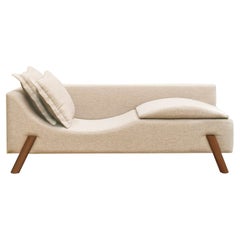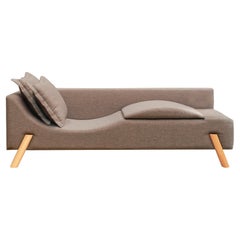Maarten Baas Sofas
Furniture designer Maarten Baas doesn't subscribe to conformist notions of beauty and symmetry. He finds appeal in the character of aged patinas and wear from usage. As such, Baas doesn't seek to create furniture or decorative objects that are perfectly proportioned — for proof, look no further than to the unconventional cabinets of his Close Parity collection or the chairs with oddly shaped backrests he designed for Lensvelt.
Baas breaks unspoken rules, and his influential work is as much art as it is functional design — he’s garnered support from likeminded creatives in his field such as Phillippe Starck and Marcel Wanders, and explores how he might put unusual materials to work such as clay or charred wood in the construction of his chairs and table lamps.
Baas was born in Germany and grew up in the Netherlands. After graduating high school, he began his studies at the Design Academy in Eindhoven. Before he had even graduated, Baas made an impression on instructors and students alike with his graduation project.
Using pieces of secondhand furniture he had procured online — some of which was manufactured by IKEA — Baas scorched the wood all the way through with a blowtorch. He soon found a way to preserve the wood once it was burned through, and this led to his inaugural Smoke series. The chairs and a lighting fixture from this line were put into production by Moooi, a furniture brand Wanders cofounded with Revised’s Casper Vissers in 2001. Hospitality guru Ian Schrager got in touch, and a pool table from the collection was custom-made by Baas for the Gramercy Park Hotel.
Since Smoke, Baas has produced numerous pieces, with his best-known efforts involving the repurposing of existing furniture and modifying it to look the way he wants. Ever the innovator, Baas introduced a series of clock designs as part of an art installation that began to take shape in 2009 at the Salone Del Mobile in Milan.
The designer’s clocks see an incorporation of video and other technology. Each piece, such as the ten-foot tall model installed at Amsterdam’s Schiphol Airport in 2016, presents the illusion of human figures toiling to keep time behind its face by way of a 12-hour recorded performance.
Baas’s works are held in the collections of many notable museums, including the Metropolitan Museum of Art in New York City.
21st Century and Contemporary Dutch Modern Maarten Baas Sofas
Upholstery
21st Century and Contemporary Dutch Modern Maarten Baas Sofas
Upholstery
21st Century and Contemporary Dutch Modern Maarten Baas Sofas
Upholstery
21st Century and Contemporary Dutch Modern Maarten Baas Sofas
Upholstery
21st Century and Contemporary Dutch Modern Maarten Baas Sofas
Upholstery
2010s Dutch Modern Maarten Baas Sofas
Steel
21st Century and Contemporary Brazilian Modern Maarten Baas Sofas
Fabric, Hardwood
21st Century and Contemporary Brazilian Modern Maarten Baas Sofas
Fabric, Hardwood
21st Century and Contemporary Dutch Modern Maarten Baas Sofas
Steel
Early 2000s French French Provincial Maarten Baas Sofas
Brass, Steel
21st Century and Contemporary Brazilian Modern Maarten Baas Sofas
Fabric, Hardwood
Early 19th Century English Regency Antique Maarten Baas Sofas
Mahogany
21st Century and Contemporary European Modern Maarten Baas Sofas
Wood, Oak
21st Century and Contemporary Italian Maarten Baas Sofas
Fabric, Velvet, Wood
Early 2000s Dutch Post-Modern Maarten Baas Sofas
Leather, Wood
21st Century and Contemporary Brazilian Modern Maarten Baas Sofas
Fabric, Hardwood
21st Century and Contemporary Dutch Modern Maarten Baas Sofas
Upholstery
21st Century and Contemporary Brazilian Modern Maarten Baas Sofas
Fabric, Hardwood







